Aluminum is lightweight, strong, corrosion-resistant, infinitely recyclable, and an essential part of our daily life.
Comprising a little over 8% of the earth’s crust, aluminum is the most abundant metal on the planet. It is the third most common element after oxygen and silicon.
In today’s modern society, aluminum products are just as abundant. Since its commercial production began little more than a century ago, aluminum has become the material of choice for a diverse range of applications and utilities.
Aluminum was once considered to be a “precious metal”, even more valuable than gold! It is said that Emperor Napoleon III of France once gave a banquet where the most honored guests were given aluminum cutlery, while everyone else had to settle for gold.
Aluminum’s intrinsic properties have contributed to its popularity and varied uses.
Aluminum’s strength can be adapted to the application required by modifying the composition of its alloys. Some alloys like 7075 T651 have strength approaching that of steel, while weighing only 1/3 as much. In vehicles, aluminum reduces unnecessary weight and therefore boosts fuel efficiency.
Releasing no taste, odors or toxins, aluminum is ideal for beverage, food and pharmaceutical packaging.
Naturally generating a protective oxide coating, aluminum’s corrosion resistance properties are particularly useful for protection and conservation of equipment used in corrosive environments.
Aluminum conducts heat and electricity twice as well as copper based on weight. Aluminum now plays a major role in power transmission lines.
Aluminum is ductile. Its low density and melting point allow products to be formed right up until the last stages of a product design.
As a reflector of heat and light, aluminum is suitable for such applications as solar technology, commercial lighting and rescue blankets.
Aluminum is 100% and infinitely recyclable with no deterioration in quality. In fact, 75% of the aluminum produced since its initial discovery is still in use today!
Utilizing recycled aluminum consumes just 5% of the energy it takes to produce from virgin materials.
Sourced from bauxite ore, the material is refined into aluminum oxide trihydrate (alumina) using the “Bayer process”, and then reduced via a smelting process into metallic aluminum. Up to four tons of bauxite are needed to produce one ton of aluminum metal.
Once formed, aluminum is alloyed with other materials, usually iron, silicon, zinc, copper and magnesium, to create aluminum alloys with different properties. The type of alloy is designated with a serial number. For example, 1000 series alloys comprise almost pure aluminum, while 7000 series denote a zinc alloy.
In its alloyed form, aluminum can be processed in a number of ways. Usually it is extruded, cast or rolled.
Extrusion: A solid aluminum cylinder called a billet (available in a variety of alloys, pretreatments and dimensions), is heated and squeezed through a die with a shaped opening to create a desired profile. Extrusions such as 6061 T6511, 2024 T3511 and 7075 T6511 are widely used in aerospace, construction, road and rail applications.
Casting: Using either sand casting or die casting techniques, the molten aluminum is shaped according to a mold.
Rolling: Aluminum ingot passes through a hot-rolling mill and is then transferred to a cold-rolling mill, which can gradually reduce the thickness of the metal down to as light as 0.002” thick foil. This is how aluminum plate like 2024, 6061 and 7075 is produced.
